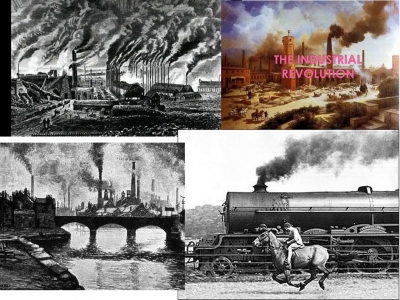
INDUSTRIAL REVOLUTION
From the late 18th century, the invention of machines that could do things faster than ever before brought dramatic changes in the way people lived and worked. Known as the Industrial Revolution, these changes took root in Britain and quickly spread to Europe and the USA. It began in the textile industry, with new machines powered first by water and later by steam. This led to a huge demand for coal, to fuel the engines, and iron, to make the machines. New towns sprang up as farm labourers moved from the countryside to work in the factories.
FACTORIES
Huge buildings, called factories, were constructed to house the new machines, row upon row. Machines, such as these looms for weaving cotton into cloth, were powered by a steam engine and the noise they made would have been deafening.
FACTORY WEAR
Factory owners preferred to hire women and children to men, because they were cheaper and easier to discipline. Women in the factories wore heavy, durable clothes, which were products themselves of the Industrial Revolution’s textile boom.
RAILWAYS
In 1804, British inventor Richard Trevithick built the first steam-powered locomotive. Early locomotives carried coal from mines. From 1825, passenger trains were built, and armies of workers lay down railway lines.
NEW TOWNS
In the factory areas, villages grew into huge towns almost overnight. Workers’ houses were built as cheaply as possible, and often crammed closely together. The industrial towns were dark places, where the air was filled with smoke from the factory chimneys.
INVENTIONS
The driving force of the Industrial Revolution was the rapid development of new ideas, methods, and machinery. Newly invented steam engines were used to power innovative new machines that transformed the mining, textiles, and metalworking industries.
DISEASE
People lived crowded together in the new factory towns. They had no proper sewers, rubbish collection, or clean drinking water. Diseases like cholera, typhus, and typhoid often swept through the towns, killing thousands.
Picture Credit : Google




